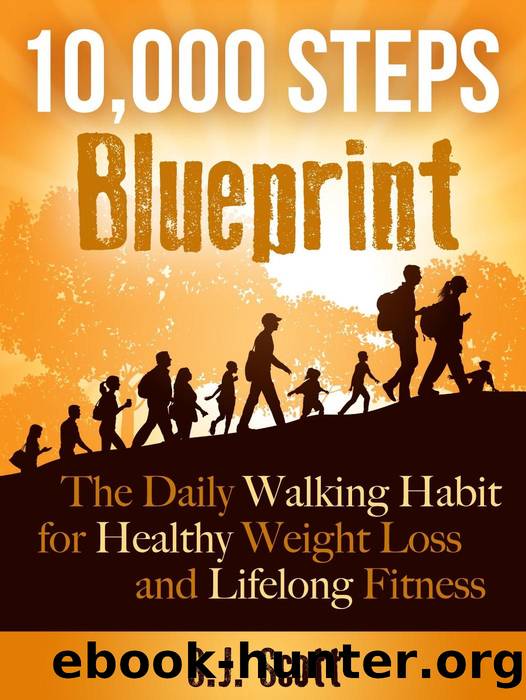10,000 Steps Blueprint--The Daily Walking Habit for Healthy Weight Loss and Lifelong Fitness by S.J. Scott

Author:S.J. Scott
Language: eng
Format: epub
Tags: 10000 steps, walking for weight loss, healthy weight loss, ways to lose weight, fast weight loss, healthy diet, walking for fitness
Publisher: S.J. Scott
Published: 2016-07-12T00:00:00+00:00
The Importance of Injury Prevention
One of the main reasons I recommend walking over running is that it minimizes injuries. In my 23 years of running, Iâve experienced ankle sprains, plantar fasciitis, muscle pulls, shin splints, chronic back aches and dancerâs hip (seriously, look that one up). Whatâs interesting is that none of these injuries were from walking, nor have I heard of other walkers getting hurt.
While frequent walking might lead an injury, the risks are minimal when compared to other activities. A major reason why is youâre doing a natural movement that doesnât cause a repetitive strain on your joints, muscles and tendons.
With all that said, injuries from walking can happen. This is especially true if you do a lot of âoff-roadingâ (like hiking or beach walking). So, as you begin a walking routine, itâs important to focus on injury prevention. Here are a few ways to do this:
** Anyone with a special condition (morbid obesity, hypertension, diabetes, etc.) should get a consultation from a doctor before starting an exercise routine. In most cases, your doctor will recommend increased activity, but a quick discussion can help identify any special precautions you should take.
** Never use weights on your ankles or arms. I see this all the time and it drives me nuts. Weights mess with your natural stride, which often leads to injury. If you want a âbetterâ exercise, walk faster or further (or both). And if you want to work out with weights, then do it in a gym.
** Itâs okay to exercise while your sore, but donât do it when youâre hurt. There is a very big distinction between the two. Anyone who hasnât exercised recently can expect some soreness. However, if youâre feeling an odd pain or youâre âfavoringâ one part of your body, then itâs important to stop immediately and take time to heal.
To clarify things:
-âSoreness is often characterized by a general dull pain in a large area.
-âInjury can be characterized by any sharp and specific pain, or any pain that follows a specific calamity, such as taking a tumble or fall.
** If there is any doubt about an injury, take a few days off and heal up. Exercising on an injury can turn a minor ailment into a major one. Itâs better to take things slow and add a few rest days if something doesnât feel right.
** If a nagging injury doesnât go away after rest, then you might have a real medical problem. In this situation, itâs important to consult a doctor, preferably one who specializes in sports related injuries.
Some injuries are unavoidable, while others can often be prevented. You can avoid many problems by buying good shoes, adding rest days and slowly ramping up your step count.
Finally, you can create an injury-free environment by following a quality warm up and cool down routine. In the next section, weâll talk about how to do this.
Download
This site does not store any files on its server. We only index and link to content provided by other sites. Please contact the content providers to delete copyright contents if any and email us, we'll remove relevant links or contents immediately.
Periodization Training for Sports by Tudor Bompa(8171)
Bodyweight Strength Training by Jay Cardiello(7844)
Born to Run: by Christopher McDougall(7066)
Inner Engineering: A Yogi's Guide to Joy by Sadhguru(6728)
Asking the Right Questions: A Guide to Critical Thinking by M. Neil Browne & Stuart M. Keeley(5650)
The Fat Loss Plan by Joe Wicks(4850)
Bodyweight Strength Training Anatomy by Bret Contreras(4614)
Yoga Anatomy by Kaminoff Leslie(4308)
Dynamic Alignment Through Imagery by Eric Franklin(4119)
Science and Development of Muscle Hypertrophy by Brad Schoenfeld(4089)
ACSM's Complete Guide to Fitness & Health by ACSM(3989)
Exercise Technique Manual for Resistance Training by National Strength & Conditioning Association(3958)
The Four-Pack Revolution by Chael Sonnen & Ryan Parsons(3933)
Bodyweight Strength Training: 12 Weeks to Build Muscle and Burn Fat by Jay Cardiello(3919)
The Ultimate Bodybuilding Cookbook by Kendall Lou Schmidt(3886)
Yoga Anatomy by Leslie Kaminoff & Amy Matthews(3865)
American Kingpin by Nick Bilton(3760)
Nutrition for Sport, Exercise, and Health by Spano Marie & Kruskall Laura & Thomas D. Travis(3715)
Yoga Therapy by Mark Stephens(3704)
